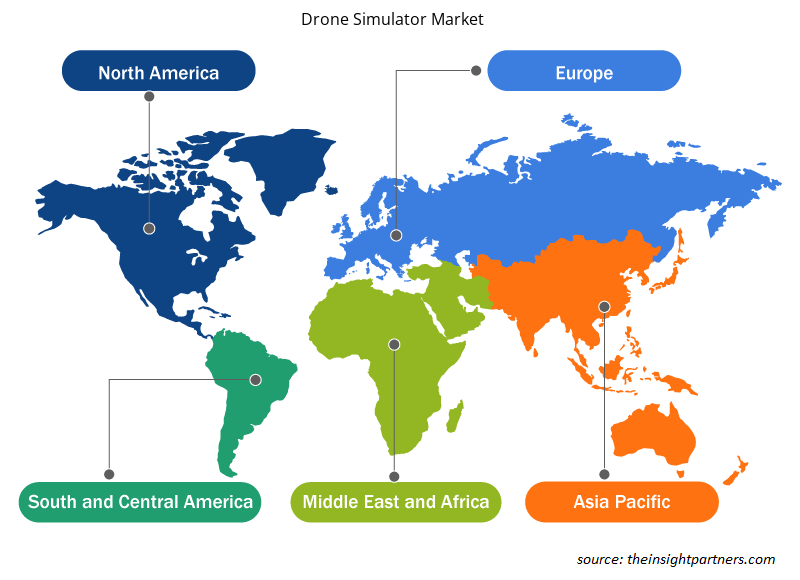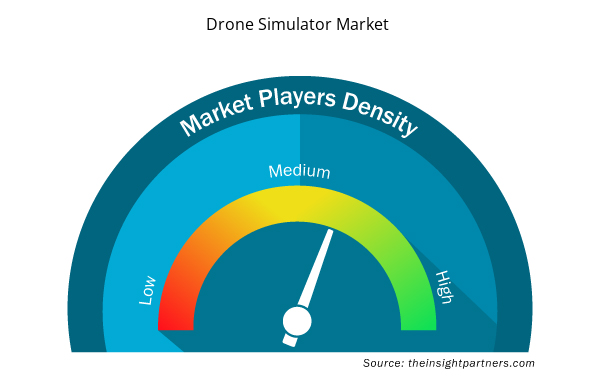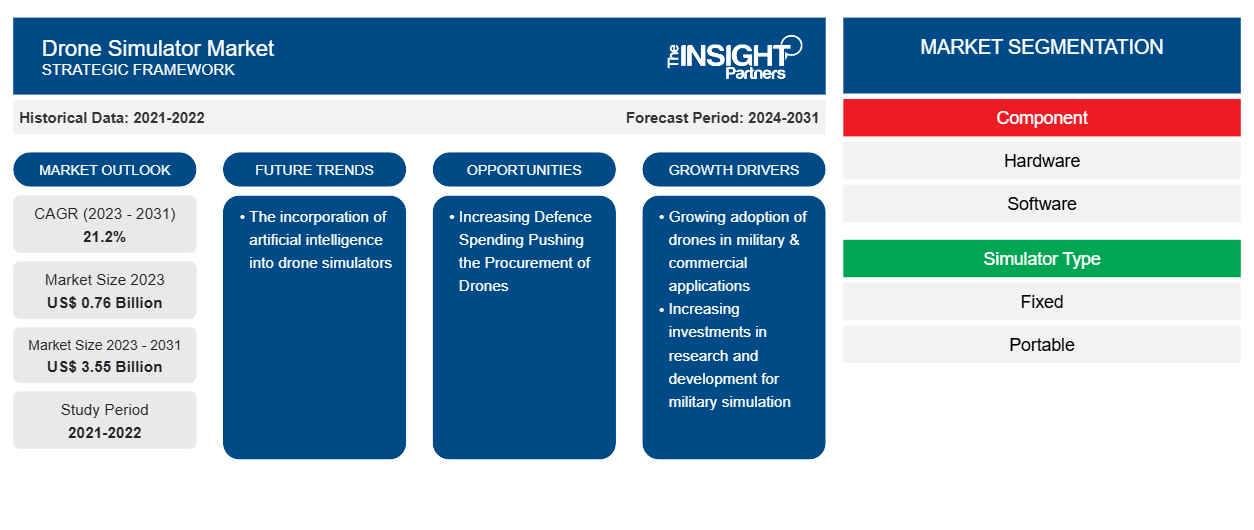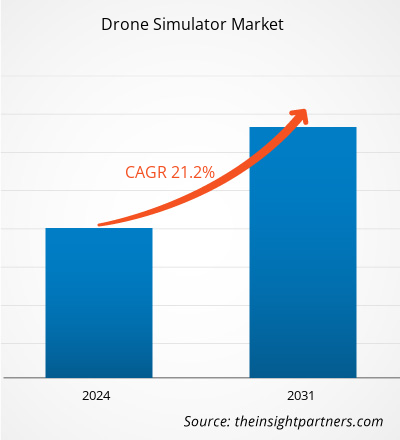无人机模拟器市场规模预计将从 2023 年的 7.6 亿美元增至 2031 年的 35.5 亿美元。预计 2023-2031 年期间该市场的复合年增长率将达到 21.2%。人工智能的融入很可能仍是市场的一个主要趋势。
无人机模拟器市场分析
无人机模拟器市场主要由行业领先的制造商主导,例如 Aegis Technologies、Leonardo Spa、General Atomics、Israel Aerospace Industries 等。无人机制造商对这些连接器的需求空前高涨。行业认可的制造商的存在和强大的品牌形象限制了新参与者进入市场。此外,无人机模拟器的制造需要遵守各自管理机构制定的多项标准,而获得制造此类产品的许可证是一个资本密集型的过程。如此巨大的资本需求是限制新兴参与者进入该市场的另一个因素。
无人机模拟器市场概况
无人机模拟器市场的主要利益相关者是组件供应商、无人机模拟器提供商和最终用户。电子供应商向无人机模拟器供应商提供传感器、摄像头和无源元件等电子组件,用于生产无人机模拟器(硬件)。最终用户可以从无人机模拟器供应商处获得适用于多种类型无人机的无人机模拟器,具体取决于他们的应用。在生产这些模拟器之前,必须遵守几项监管规则。无人机模拟器供应商从根本上拥有技术能力,可以为军事和航空航天工业提供有效且值得信赖的模拟系统。最后,商业和军事组织等最终用户使用无人机模拟器来测试各种应用程序。
定制此报告以满足您的需求
您可以免费定制任何报告,包括本报告的部分内容、国家级分析、Excel 数据包,以及为初创企业和大学提供优惠和折扣
- 获取此报告的关键市场趋势。这个免费样品将包括数据分析,从市场趋势到估计和预测。
无人机模拟器市场驱动因素和机遇
增加军事模拟研发投入
许多国家的军事部门都在削减训练开支,缩减军队规模。因此,军方的注意力转向寻找更便宜、更有效的解决方案来满足他们的需求。实时训练既耗时又费钱。此外,它需要大量的原始资源,如汽油和炸药,而且危险性很高。因此,军事部门越来越倾向于使用大数据、人工智能和云计算等技术的虚拟训练和基于模拟的游戏。军事模拟和虚拟训练在世界各地的军队中越来越受欢迎,因为它们基于商用现货 (COTS) 组件,有助于最大限度地降低训练费用。模拟器的开发成本极低。这些标准对于军方大规模创新基于模拟的训练技术至关重要。无人机模拟目前用于训练未来的士兵,并使用真实的数字设置来呈现实时场景。因此,模拟软件支出的增加推动了无人机模拟器市场的增长。此外,一些国家的国防部正在采用新的解决方案重组和改变军队,这也促进了市场的增长。
增加国防开支推动无人机采购
现代战争的迅速变化促使各国政府向各自的军事力量分配更多资金。分配给军队的预算有助于军队致力于开发强大的本土技术,并从国际制造商那里采购先进的武器、军备、车辆和其他设备。大多数军队越来越多地采用无人系统,以使人员和车辆随时准备执行任务。为了实现士兵和车辆的现代化,全球各国国防部正在大量投资于新技术,包括无人机系统。这一因素推动了无人机模拟器市场的增长,为武装部队提供采购无人机的培训。根据斯德哥尔摩国际和平研究所 (SIPRI) 的数据,2023 年全球军费开支将增至 24,430 亿美元,比 2022 年增长约 13%。2023 年的主要国家包括美国、中国、印度、俄罗斯和沙特阿拉伯,占全球支出的约 60%。这些投资促进了来自世界各地的无人机模拟器的采购和订单,进一步推动了市场增长。
无人机模拟器市场报告细分分析
有助于得出无人机模拟器市场分析的关键部分是组件、模拟器类型、无人机类型和技术。
- 根据组件,无人机模拟器市场分为硬件和软件。硬件部分在 2023 年占据了更大的市场份额。
- 根据模拟器类型,无人机模拟器市场分为固定式和便携式。固定式部分在 2023 年占据了更大的市场份额。
- 根据无人机类型,无人机模拟器市场分为固定翼和旋翼。2023 年,全固定翼部分占据了更大的市场份额。
- 根据技术,无人机模拟器市场分为增强现实和虚拟现实。虚拟现实领域在 2023 年占据了更大的市场份额。
无人机模拟器市场份额按地区分析
无人机模拟器市场报告的地理范围主要分为五个地区:北美、欧洲、亚太、中东和非洲、南美。
2023 年,北美占据了市场主导地位,其次是欧洲和亚太地区。此外,亚太地区在未来几年也可能出现最高的复合年增长率。美国在 2023 年主导了北美无人机模拟器市场。美国无人机模拟器市场的增长归因于无人机在军事和商业应用中的使用。美国军队使用无人机进行态势感知。态势感知提供有关敌人位置、地形、天气和其他变化变量的实时信息。无人机有助于获取有关战区部队位置的信息,以便做出更好的决策。战争结束后,无人机用于战斗评估伤害分析。此外,随着美国国防开支的增加,无人机的使用也随之增加。例如,美国在 2023 年的军费开支约为 9160 亿美元,与 2022 年的约 8760 亿美元相比增长了约 4.6%。这些因素一直在推动无人机模拟器市场的采用。
无人机模拟器市场区域洞察
Insight Partners 的分析师详细解释了预测期内影响无人机模拟器市场的区域趋势和因素。本节还讨论了北美、欧洲、亚太地区、中东和非洲以及南美和中美洲的无人机模拟器市场细分和地理位置。

- 获取无人机模拟器市场的区域特定数据
无人机模拟器市场报告范围
| 报告属性 | 细节 |
|---|---|
| 2023 年的市场规模 | 7.6亿美元 |
| 2031 年市场规模 | 35.5亿美元 |
| 全球复合年增长率(2023 - 2031) | 21.2% |
| 史料 | 2021-2022 |
| 预测期 | 2024-2031 |
| 涵盖的领域 | 按组件
|
| 覆盖地区和国家 | 北美
|
| 市场领导者和主要公司简介 |
|
无人机模拟器市场参与者密度:了解其对业务动态的影响
无人机模拟器市场正在快速增长,这得益于终端用户需求的不断增长,这些需求源于消费者偏好的不断变化、技术进步以及对产品优势的认识不断提高等因素。随着需求的增加,企业正在扩大其产品范围,进行创新以满足消费者的需求,并利用新兴趋势,从而进一步推动市场增长。
市场参与者密度是指在特定市场或行业内运营的企业或公司的分布情况。它表明在给定市场空间中,相对于其规模或总市场价值,有多少竞争对手(市场参与者)存在。
在无人机模拟器市场运营的主要公司有:
- 宙斯盾技术公司
- CAE公司
- 通用原子公司
- 哈维尔桑
- 以色列航空工业有限公司
- L3 链路训练与模拟
免责声明:上面列出的公司没有按照任何特定顺序排列。

- 获取无人机模拟器市场顶级关键参与者概览
无人机模拟器市场新闻和最新发展
无人机模拟器市场通过收集一手和二手研究后的定性和定量数据进行评估,其中包括重要的公司出版物、协会数据和数据库。以下列出了无人机模拟器市场的一些发展情况:
- CAE 宣布已与 L3Harris Technologies (NYSE: LHX) 达成正式协议,以 10.5 亿美元收购 L3Harris 的军事训练业务(简称“收购”),但需进行正常调整。收购价值约为 L3Harris 军事训练业务估计调整后的 2020 年 EBITDA 的 13.5 倍,或约 10 倍于成本协同效应,预计在收购完成后的第二年年底,每年将达到 3500 万至 4500 万加元(约合 2800 万至 3500 万美元)。(来源:CAE Inc,新闻稿,2021 年)
- 以色列航空工业公司 (IAI) 将通过微软的 Azure云计算服务平台,为世界各地的政府、学院、高等教育机构和企业提供学习如何防御网络威胁的机会。在培训方面,TAME RANGE 网络培训平台提供了一个逼真的交互式学习环境,可模拟真实威胁。(来源:以色列航空工业公司,新闻稿,2021 年)
无人机模拟器市场报告覆盖范围和交付成果
“无人机模拟器市场规模和预测(2021-2031)”报告对以下领域进行了详细的市场分析:
- 无人机模拟器市场规模及全球、区域和国家层面所有关键细分市场的预测
- 无人机模拟器市场趋势以及市场动态,如驱动因素、限制因素和关键机遇
- 详细的波特五力分析
- 无人机模拟器市场分析涵盖主要市场趋势、全球和区域框架、主要参与者、法规和最新市场发展
- 行业格局和竞争分析,涵盖市场集中度、热图分析、知名参与者以及无人机模拟器市场的最新发展
- 详细的公司简介
- 历史分析(2 年)、基准年、预测(7 年)及复合年增长率
- PEST 和 SWOT 分析
- 市场规模价值/数量 - 全球、区域、国家
- 行业和竞争格局
- Excel 数据集


- Clear Aligners Market
- Explosion-Proof Equipment Market
- Electronic Shelf Label Market
- Volumetric Video Market
- Maritime Analytics Market
- Data Annotation Tools Market
- Analog-to-Digital Converter Market
- Quantitative Structure-Activity Relationship (QSAR) Market
- Truck Refrigeration Market
- Diaper Packaging Machine Market

Report Coverage
Revenue forecast, Company Analysis, Industry landscape, Growth factors, and Trends

Segment Covered
This text is related
to segments covered.

Regional Scope
North America, Europe, Asia Pacific, Middle East & Africa, South & Central America

Country Scope
This text is related
to country scope.
常见问题
North America region dominated the drone simulator market in 2023.
Growing adoption of drones in military & commercial applications and increasing investments in research and development for military simulation are some of the factors driving the growth for drone simulator market.
The incorporation of artificial intelligence into drone simulators is one of the major trends of the market.
Aegis Technologies, CAE Inc, General Atomics, Havelsan AS, Israel Aerospace Industries Ltd, L3 Link Training & Simulation, Leonardo SpA, Sikan Nutzfahrzeuge GmbH, Simlat Uas Simulation, Singapore Technologies Electronics Limited, and Zen Technologies Limited are some of the key players profiled under the report.
The estimated value of the drone simulator market by 2031 would be around US$ 3.55 billion.
The drone simulator market is likely to register of 21.2% during 2023-2031.
Trends and growth analysis reports related to Aerospace and Defense : READ MORE..
The Insight Partners performs research in 4 major stages: Data Collection & Secondary Research, Primary Research, Data Analysis and Data Triangulation & Final Review.
- Data Collection and Secondary Research:
As a market research and consulting firm operating from a decade, we have published and advised several client across the globe. First step for any study will start with an assessment of currently available data and insights from existing reports. Further, historical and current market information is collected from Investor Presentations, Annual Reports, SEC Filings, etc., and other information related to company’s performance and market positioning are gathered from Paid Databases (Factiva, Hoovers, and Reuters) and various other publications available in public domain.
Several associations trade associates, technical forums, institutes, societies and organization are accessed to gain technical as well as market related insights through their publications such as research papers, blogs and press releases related to the studies are referred to get cues about the market. Further, white papers, journals, magazines, and other news articles published in last 3 years are scrutinized and analyzed to understand the current market trends.
- Primary Research:
The primarily interview analysis comprise of data obtained from industry participants interview and answers to survey questions gathered by in-house primary team.
For primary research, interviews are conducted with industry experts/CEOs/Marketing Managers/VPs/Subject Matter Experts from both demand and supply side to get a 360-degree view of the market. The primary team conducts several interviews based on the complexity of the markets to understand the various market trends and dynamics which makes research more credible and precise.
A typical research interview fulfils the following functions:
- Provides first-hand information on the market size, market trends, growth trends, competitive landscape, and outlook
- Validates and strengthens in-house secondary research findings
- Develops the analysis team’s expertise and market understanding
Primary research involves email interactions and telephone interviews for each market, category, segment, and sub-segment across geographies. The participants who typically take part in such a process include, but are not limited to:
- Industry participants: VPs, business development managers, market intelligence managers and national sales managers
- Outside experts: Valuation experts, research analysts and key opinion leaders specializing in the electronics and semiconductor industry.
Below is the breakup of our primary respondents by company, designation, and region:

Once we receive the confirmation from primary research sources or primary respondents, we finalize the base year market estimation and forecast the data as per the macroeconomic and microeconomic factors assessed during data collection.
- Data Analysis:
Once data is validated through both secondary as well as primary respondents, we finalize the market estimations by hypothesis formulation and factor analysis at regional and country level.
- Macro-Economic Factor Analysis:
We analyse macroeconomic indicators such the gross domestic product (GDP), increase in the demand for goods and services across industries, technological advancement, regional economic growth, governmental policies, the influence of COVID-19, PEST analysis, and other aspects. This analysis aids in setting benchmarks for various nations/regions and approximating market splits. Additionally, the general trend of the aforementioned components aid in determining the market's development possibilities.
- Country Level Data:
Various factors that are especially aligned to the country are taken into account to determine the market size for a certain area and country, including the presence of vendors, such as headquarters and offices, the country's GDP, demand patterns, and industry growth. To comprehend the market dynamics for the nation, a number of growth variables, inhibitors, application areas, and current market trends are researched. The aforementioned elements aid in determining the country's overall market's growth potential.
- Company Profile:
The “Table of Contents” is formulated by listing and analyzing more than 25 - 30 companies operating in the market ecosystem across geographies. However, we profile only 10 companies as a standard practice in our syndicate reports. These 10 companies comprise leading, emerging, and regional players. Nonetheless, our analysis is not restricted to the 10 listed companies, we also analyze other companies present in the market to develop a holistic view and understand the prevailing trends. The “Company Profiles” section in the report covers key facts, business description, products & services, financial information, SWOT analysis, and key developments. The financial information presented is extracted from the annual reports and official documents of the publicly listed companies. Upon collecting the information for the sections of respective companies, we verify them via various primary sources and then compile the data in respective company profiles. The company level information helps us in deriving the base number as well as in forecasting the market size.
- Developing Base Number:
Aggregation of sales statistics (2020-2022) and macro-economic factor, and other secondary and primary research insights are utilized to arrive at base number and related market shares for 2022. The data gaps are identified in this step and relevant market data is analyzed, collected from paid primary interviews or databases. On finalizing the base year market size, forecasts are developed on the basis of macro-economic, industry and market growth factors and company level analysis.
- Data Triangulation and Final Review:
The market findings and base year market size calculations are validated from supply as well as demand side. Demand side validations are based on macro-economic factor analysis and benchmarks for respective regions and countries. In case of supply side validations, revenues of major companies are estimated (in case not available) based on industry benchmark, approximate number of employees, product portfolio, and primary interviews revenues are gathered. Further revenue from target product/service segment is assessed to avoid overshooting of market statistics. In case of heavy deviations between supply and demand side values, all thes steps are repeated to achieve synchronization.
We follow an iterative model, wherein we share our research findings with Subject Matter Experts (SME’s) and Key Opinion Leaders (KOLs) until consensus view of the market is not formulated – this model negates any drastic deviation in the opinions of experts. Only validated and universally acceptable research findings are quoted in our reports.
We have important check points that we use to validate our research findings – which we call – data triangulation, where we validate the information, we generate from secondary sources with primary interviews and then we re-validate with our internal data bases and Subject matter experts. This comprehensive model enables us to deliver high quality, reliable data in shortest possible time.


 获取此报告的免费样本
获取此报告的免费样本